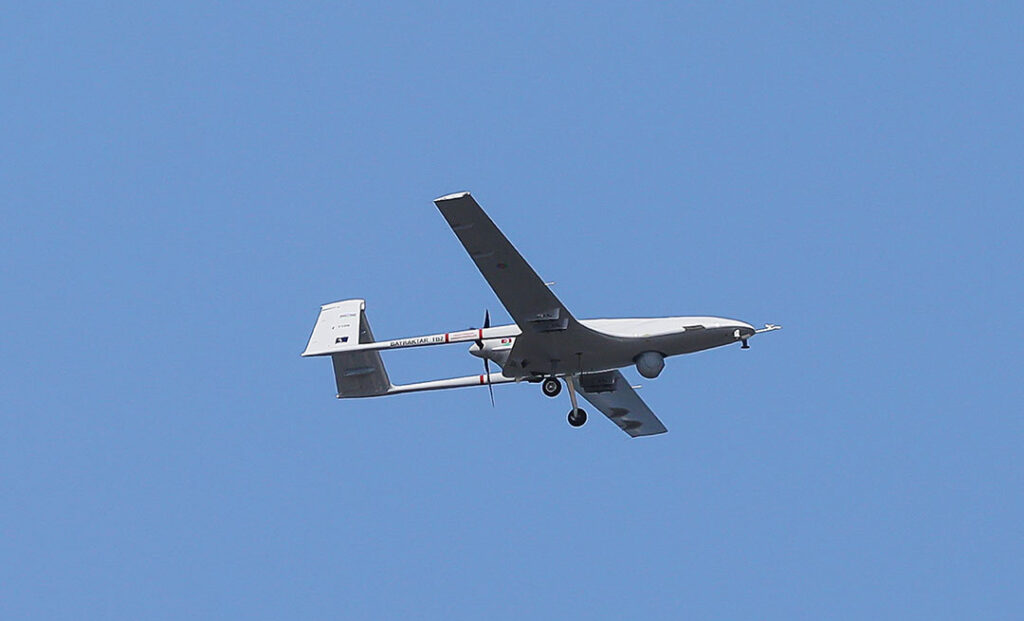SALTANAT BERDIKEEVA, Unipath Staff
In October 2021, Kyrgyzstan bought new military unmanned aerial vehicles (UAVs) from Turkey to protect its border. The Bayraktar UAV was Kyrgyzstan’s first major investment in military UAVs, commonly known as drones, that fly without pilots or passengers. Only a month later, Kazakhstan acquired the same UAVs for its military in light of growing security threats from Afghanistan.
Although drones are not new to Central Asia, the greater integration of UAVs into the armed forces illustrates the benefits of unmanned technology for national security. The drone strikes on oil processing facilities in Saudi Arabia in 2019 have elevated fears that similar attacks by nonstate actors could target Central Asia. Regional governments appear most interested in enlisting drones to broaden their reconnaissance and defensive arsenals.
Military UAVs
Since 2016, Kazakhstan, Turkmenistan and Uzbekistan have acquired large military-grade drones mainly for surveillance and monitoring. In Kazakhstan, they have been spotted at military parades and exercises. Kazakhstan also manufactures three UAV models, which are used for agriculture, oil production and geographical surveys. Turkmenistan has several types of military drones, including the Turkish Bayraktar, which have the capacity to carry bombs.
Kyrgyz President Sadyr Japarov stressed that its recent acquisition of the Turkish military drones is purely for defense.
“We have never in 30 years started a conflict with anyone, have not seized foreign territories with weapons in our hands. And this will not happen in the future,” the president said.
While Uzbekistan has restricted the use of any type of drone, the country has loosened its restrictions since 2016. The Uzbek Armed Forces deploy two types of military drones for surveillance and monitoring. Although Tajikistan has revealed little about its use of military drones, it has reportedly used United Nations-donated UAVs for search and rescue missions in mountainous terrain.
New Tools in Security Toolbox UAVs provide special benefits for Central Asian countries in their efforts to patrol lightly populated terrain, conduct environmental remediation projects, combat drug smuggling and disrupt the movement of terrorists across borders.
One of the increasingly important ways drones are used is monitoring radiation levels at contaminated uranium legacy sites. The International Atomic Energy Agency (IAEA) is collaborating with the governments of Kazakhstan, Kyrgyzstan, Uzbekistan and Tajikistan to decontaminate former uranium mining sites in the Ferghana Valley.
One of the most heavily populated areas of Central Asia, Ferghana is exposed to radiation and heavy metals from unsecured former uranium mines and waste dumps. Earthquakes and landslides native to the region increase the risk that contamination could spread.
Drones equipped with gamma-ray detectors are considered the safest and most effective tool to monitor radioactivity, particularly in difficult mountainous terrain prone to earthquakes. Drones not only reduce the risk of human contamination, but also can typically gather data more efficiently.
The first phase of the IAEA project included mapping uranium sites in Central Asia in 2020. The next phase will be training personnel in the region on using drones to clean up nuclear waste.
While law enforcement agencies in the region have expressed concern that drug traffickers also can use drones, they also see drones as attractive tools to fight such trafficking.
Kyrgyzstan’s Counter Narcotics Service of the Ministry of Interior has shown interest in using drones to capture drug smugglers. Images captured with drones could help identify illegal crops and provide vital intelligence otherwise difficult to obtain.
“The introduction of UAVs to the Counter Narcotics Service is the first innovative approach in Central Asia,” said Andrey Seleznev, head of the United Nations Office on Drugs and Crime in Kyrgyzstan.
Regional governments have shown particular interest in drones as a necessary tool for disaster planning and response. All five countries face various levels of risks from natural disasters. While earthquakes are most common in the region, Central Asia also suffers frequently from floods, landslides, mudslides and avalanches.
Drones don’t just pinpoint the sites of disasters, but if properly equipped can transport critical supplies to remote locations.
In November 2021, at a meeting in Tashkent, heads of the Ministries of Emergency Situations of the five Central Asian countries approved the use of drones for disaster prevention and emergency response. The “Concept for the Use of UAVs” agreement is part of the larger Strategy for the Development of Cooperation for 2022-2030 signed by the five governments.
Monitoring the Afghan border
Drones are also becoming necessary for keeping the peace and promoting security along the Afghan border. Tajikistan, Turkmenistan and Uzbekistan possess lengthy borders with Afghanistan. Establishment of a Taliban government in Kabul has raised concerns that violent extremists could launch incursions into neighboring countries.
In August 2021, Uzbekistan conducted aerial reconnaissance along the Afghan border with the help of drones. Kazakhstan justified the recent acquisition of Bayraktar drones from Turkey as a means to respond to any security threats coming from terrorists in Afghanistan.
While Central Asian countries see opportunities in using drones for military, intelligence, rescue and civil protection services, they also recognize the that drones could become powerful weapons in the hands of hostile forces. Commercial drones are now cheap and easy to obtain. Fears are rising that simple drones converted for military purposes could carry bombs to target crowds, strategically important sites and infrastructure, or troop positions.
Regional governments seek to build the technical and military capabilities of their armed forces to anticipate, prevent and halt threats from drone attacks. They emphasize training troops to shoot down hostile drones to defend military installations.
Some analysts argue that the Central Asian states would benefit from a unified approach to balancing security and economic benefits of UAV technology. Governments could negotiate which types of drones are permissible and where to restrict their use.
Unifying drone policies could also help address potential proliferation of military UAVs in the hands of criminals and terrorists.

